Some of the most wonderful purple indoor plants you can get are
- Calathea
- Rex begonia
- Wandering Jew
- Purple sweet potato vine
- Ti plant
- Purple passion plant
- Coleus
We will discuss these great types of purple plants in this list, including their botanical description and how to care for them.
1) Calatheas
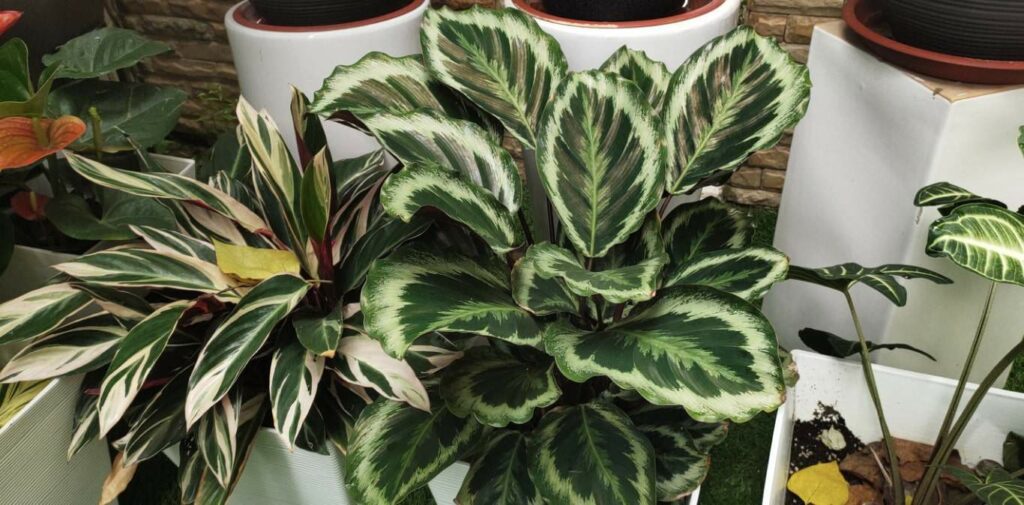

Calatheas are supremely beautiful houseplants with striking, elongated, and subtly undulating leaves.
There are lots of varieties that wear purple tones. Some of these are the Jungle Velvet, the rattlesnake plant, and the stromanthifolia.
- Jungle Velvet (Calathea warscewiczii) – This is a stylish Calathea having purple shades underneath its long fishtail foliage.
- Rattlesnake plant (Calathea lancifolia) – Aptly named, this species has a snake-like body with dark spots also sporting a deep purple under each leaf.
- Stromanthifolia (Calathea stromanthifolia) – This is a Bolivian Calathea perennial with artful dark green oval leaves and narrow purple stems.
One of the most famous and easiest-to-care-for house plants, Calatheas can tolerate medium to low, indirect light and are excellent as a table or shelf centerpiece or a garden feature.
Indoors, they don’t grow that big (only 1 to 2 feet tall), so there’s often no issue when it comes to space. Use distilled water when watering them and only when the topsoil has become dry.
2) Rex Begonia (Begonia rex-cultorum)
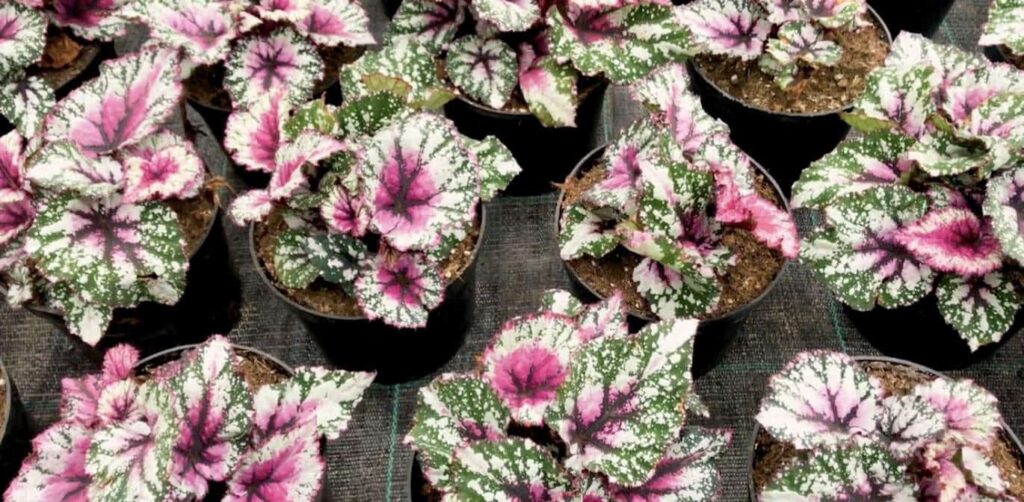

Many people find the rex begonia plant to be more exciting than other kinds of houseplants. One reason for this is it has varying leaf shapes, patterns, and hues.
Its leaves can take on the form of hearts, seashell swirls, or a lighter fire like in the picture above.
Moreover, it can have a dark color filling the middle part, lining the leaf veins, or other patterns. And its color comes in bright red, purple, green, gray, silver, and pink.
Besides being very pleasing to the eyes, this tropical plant is so easy to care for that even a beginner would have no problem with it.
Since rex begonias are born from a thick knobby stem called rhizomes or a creeping rootstalk from where the shoots and roots develop, they must be set in a shallow and large pot to give the roots enough space to grow.
To grow at its best, it needs bright shaded sun every day, so you have to locate it near an east-facing window.
Also, water it sparingly until the soil is lightly and evenly moist. It doesn’t like sodden soil, which can cause problems like falling or withering leaves.
3) Wandering Jew (Tradescantia zebrina)
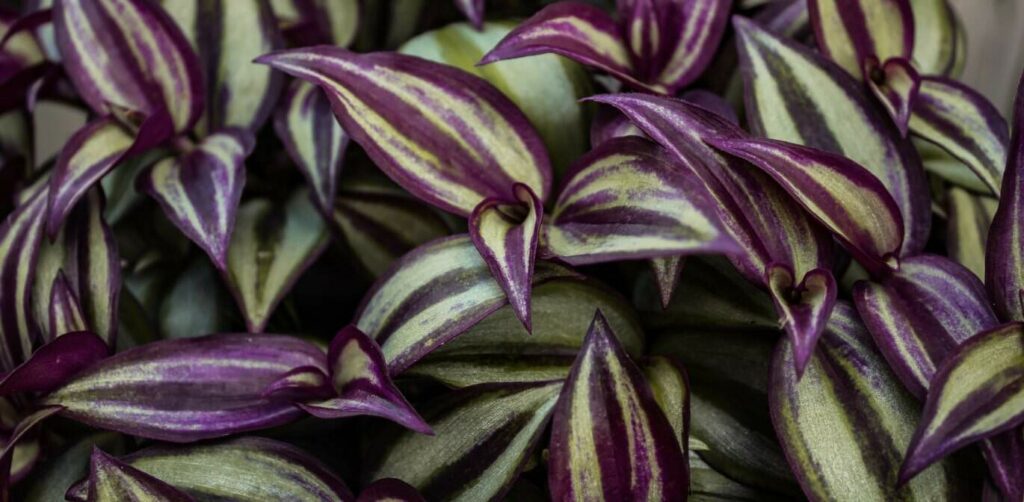

The wandering Jew is a riveting trailing vine you can place on decorative and elaborate hanging pots and baskets. Its leaves are slender and ovalish, curving nicely toward a pointed end.
Common ones have purple highlights on the middle and side parts of the plant with burgundy undersides.
Some species, though, have a bold purple on either side of the leaf, both on the top and bottom, giving it a stylish and royal appeal.
To achieve and maintain these dramatic purple colors, you have to place them somewhere with bright, filtered light.
However, don’t put them too close to the window or outside in intense summer sun, as their leaves can suffer from severe burns.
The plant prefers fairly cool and moderate temperatures from 55℉ to 70℉ indoors. It also requires frequent watering whenever the soil has dried out.
We think the wandering Jew is one of the most unique and beautiful purple plant varieties. This plant is fantastic for entrances, hallways, mantels, and shelves in your house.
4) Purple Sweet Potato Vine (Ipomoea batatas)
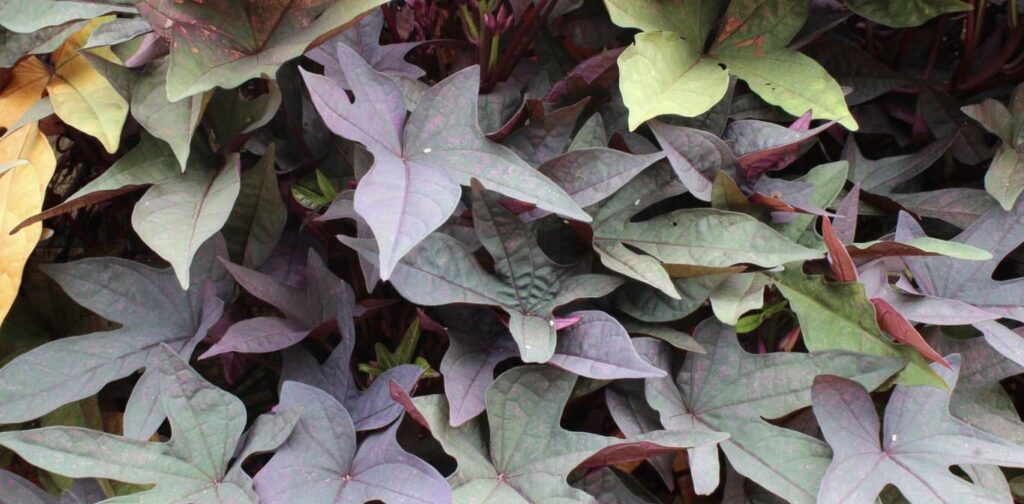

Sweet potato vine is scientifically named Ipomoea batatas. It presents brilliant somewhat star-shaped leaves with deep lobes.
These leaves can differ in color, coming in black, copper, bronze, lime green, or purple. These colors can be faint or vivid, both of which are equally fascinating.
It’s a terrific houseplant that can be planted in garden borders and beds and regular and hanging pot vessels.
But since it is sensitive to heat, cold, and winds outside, we highly suggest growing the sweet potato vine indoors.
And because the graceful vine spreads easily, you may want to give it a trellis support to encourage upward growth in your house, preventing it from using up more space on the floor.
Also, sweet potato leaves can be eaten raw or cooked as a nutritious vegetable, which has many vitamins and minerals like vitamin B, beta carotene, iron, zinc, and calcium.
By the way, you can harvest them when the plant is established in the pot vessel and is growing optimally for the best flavor and aroma.
Unlike most purple plants, the sweet potato vine loves basking in full, mild sun. Filtered and semi-filtered light will also work, though its leaf will have less striking colors.
5) Ti Plant (Cordyline fruticosa)
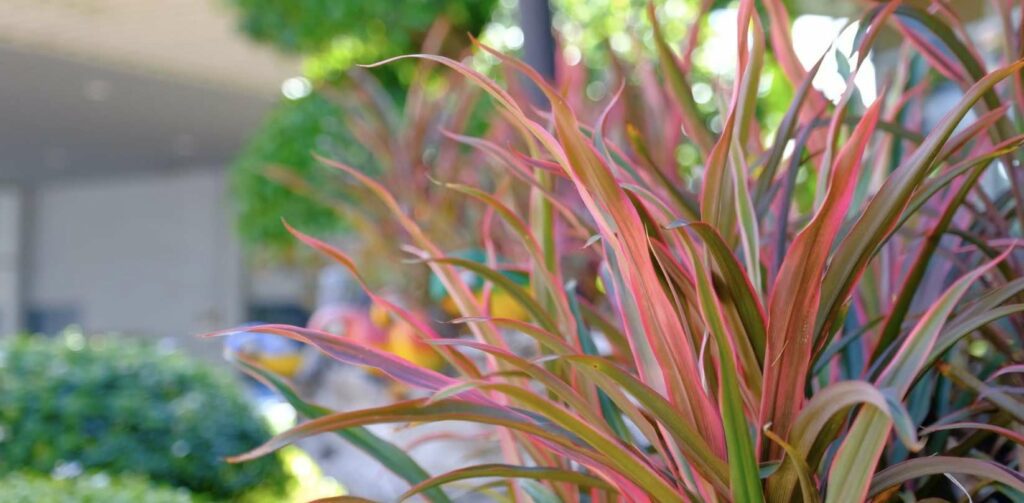

The Ti plant or Hawaiian Ti plant is an evergreen tropical plant native to Asia, Australia, and the Pacific Islands (including Tonga, Fiji, and Samoa).
It has amazing blush pink and purple leaves that hang in all directions reminiscent of the palm tree.
It’s a fast-growing plant that can have a mature size of 2 to 10 feet tall and 3 to 4 feet spread. Due to this, the plant or tree has to be repotted as it grows larger and bulkier.
In other words, you have to allot a large space for the Ti plant so that it grows comfortably in its pot container and it won’t be hard to transfer if needed.
Anyhow, the eye-catching plant is a bit harder to care for relative to other purple varieties.
It enjoys getting bright sunlight indoors. Unfortunately, it cannot thrive in poor light conditions, which will result in its leaves having a less vibrant color.
What’s more, frequent watering is needed to keep its soil consistently moist. Don’t drown it in water to protect it from rotting roots, spot issues, and pest problems.
6) Purple Passion Plant (Gynura aurantiaca)
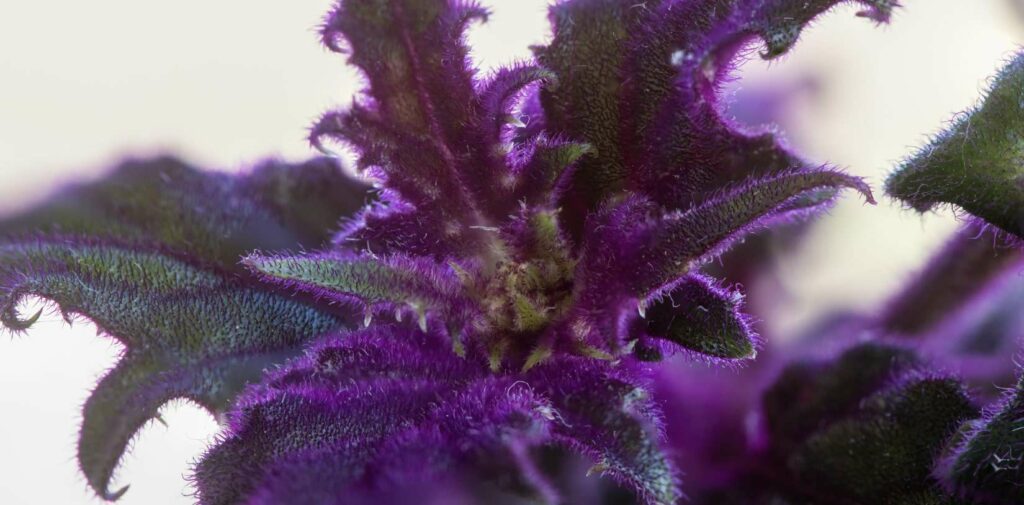

The purple passion plant aka velvet plant is an evergreen herb or vine plant originating from Indonesia.
It’s related to the amazing aster family, which notably includes daisies, dandelions, artichokes, chicories, and lettuces.
It’s characterized by its long, serrated leaves that are predominantly marked with purple edges and have fuzzy hairs.
Not only that but it can grow enchantingly rustic vines toward the ground, reaching 5 feet at the most.
So it can easily stand out with its bold color wherever you put it in the house. By autumn, it’s ready to adorn your house with its leaves and colors at their best.
To make it an artistic plant piece, choose a hanging container with nice colors and patterns from which the vines can cascade out with hypnotic beauty.
Concerning plant care, it needs shaded morning sun daily and porous, well-draining soil to prevent it from staying sodden.
Additionally, don’t sprinkle or mist the leaves too much, as their hairs tend to trap moisture, which can lead to mold or mildew growth if they are not dried thoroughly.
And, as opposed to other plants, you must allow the upper 1/4 of the soil to dry out before watering the purple passion plant again.
7) Coleus (Coleus scutellarioides)
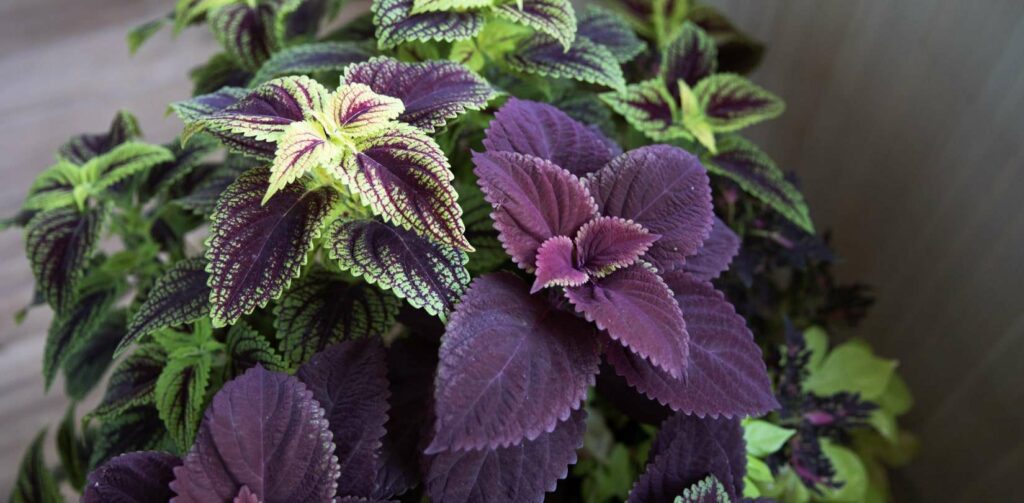

Coleus is an underrated and yet another wonderful purple plant you can grow indoors. Its native home is in Southeast Asia, Africa, and Australia.
Its foliage is broad and lance-shaped, growing beautifully in opposite directions from the center like mirror images.
If you think they look like mint or deadnettle, you’re absolutely right, as the three of them are related to each other.
The genus Coelus has several species that carry a dignified purple color on the entire or parts of the leaves, including
- The Black Dragon (Coleus Plectranthus scutellarioides) – It has a combination of light red and dark purple colors on the leaves. True to its name, each one indeed looks like a wing of a fairytale black dragon.
- Campfire (Solenostemon scutellarioides “Campfire”) – This one is pretty unusual looking and very much like a poinsettia only with a purple center. With its superb color, the Campfire makes for great border and container plants.
- Fishnet Stockings (Coleus Plectranthus scutellarioides) – On the other hand, this one has exciting lime green leaves with super dark purple running through the veins. These leaves appear darker if they get full morning sun regularly.
Generally, these purple plants aren’t big growers. They can only grow up to 3.5 feet high and 3 feet wide. So there’s plenty of space where you can keep them inside your home sweet home.
Besides that, you have to keep an eye out for this plant, as it needs more specific care. Plant it in organic potting soil, place it where it gets full sun in the morning, and water it constantly so the soil stays moist all the time.
8) Purple Sword Plant (Alocasia lauterbachiana)
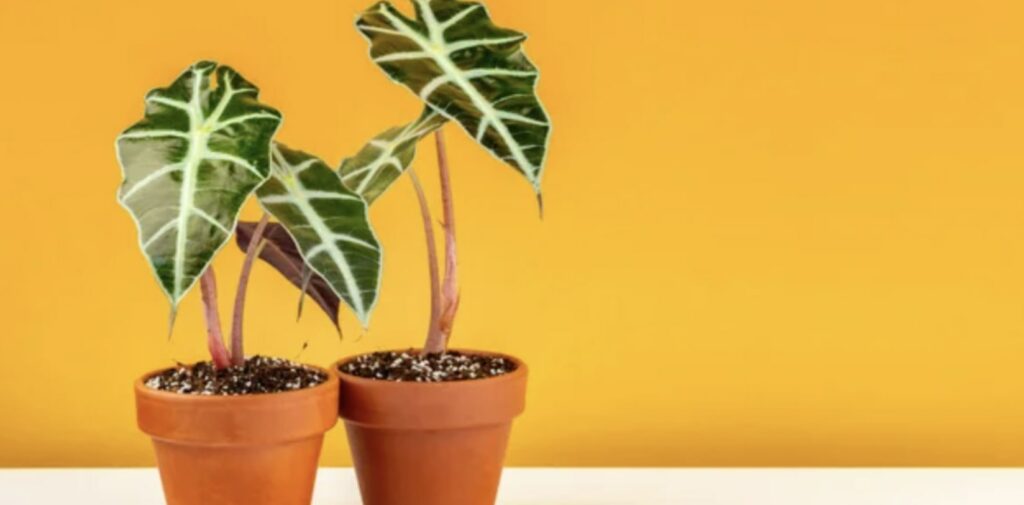

Purple sword Alocasia is a rare and spectacular purple plant native to the Philippines. It is perfect as a bench or corner plant by an east or west-facing window that gives ample partial sun.
Its name references its large, glossy, dark olive, sword-shaped leaves. Under which are purple and golden brown colors.
Young and developing purple swords will have an upright “sword” formation, and mature ones will have hanging leaves like the ones shown in the photo above.
The leaf’s veins are large, radiating from two starting points. Its fleshy and strong stem bends to support each leaf’s weight as it grows bigger in time.
Growing from bulbous roots, it’s a resilient plant compared to others. That’s because even if it loses most or all its leaves, its healthy bulb will use the stored energy to produce new ones.
Caring for the purple sword plant isn’t that hard. Just place it on a spot where it gets partial sunlight for several hours a day and water it when the top 25% to 50% of the soil has dried out.
Apart from that, it thrives in a mild and more humid environment (from 60 to 75 percent), so setting it in the bedroom as well as the bathroom or kitchen is also preferable.



